Hammond M-3
So, after keeping an eye out for several years for a Hammond spinet, I
finally landed one, and on further reading, it looks like I got pretty
much the ideal one for my needs.
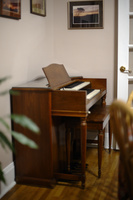
One of the major requirements was that it fit the organ trailer.
It will do this, perhaps even just by gently squeezing the front legs
together. If not, I'll need to remove one, or if I'm lucky just tuck it
just inside a wheel well.
What I ended up with is a Hammond M-3.
It is serial number 143465 with an aftermarket "Organ Mate" reverb unit
by Electro Tone Corp. It was originally purchased on July 28th, 1960 in
Renfrew, Ontario, Canada. It was delivered with the original warranty
card in the bench and the oiling chart on the bottom of the inside of
the bench untouched.
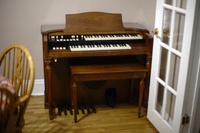 Installed and warranty
Installed and warranty
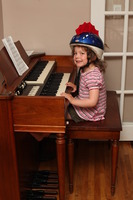 Testing...
Testing...
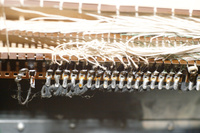 Poor-Man's Foldback modification completed and tested
Poor-Man's Foldback modification completed and tested
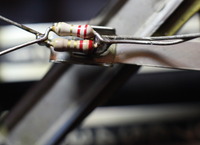 Broken drawbar resistor fix
Broken drawbar resistor fix
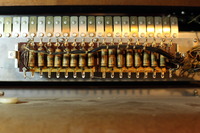 vibrato line,
drawbar guts, reverb, speaker, preamp, cabinet datecode
vibrato line,
drawbar guts, reverb, speaker, preamp, cabinet datecode
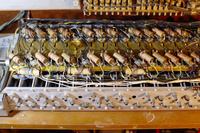 guts:
overall, vibrato scanner, synchronous motor, tonewheel generator,
starter motor, upper and lower drawbars and matching transformer can
guts:
overall, vibrato scanner, synchronous motor, tonewheel generator,
starter motor, upper and lower drawbars and matching transformer can
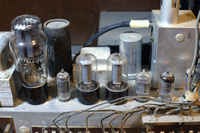 AO-29 K
preamp/amp original guts
AO-29 K
preamp/amp original guts
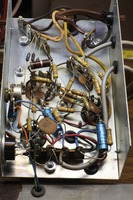 Recapping ElectroTone OrganMate reverb amp
Recapping ElectroTone OrganMate reverb amp
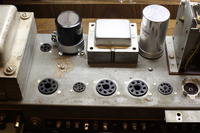 Recapping Hammond M-3 AO-29-7 K pre/power amp
Recapping Hammond M-3 AO-29-7 K pre/power amp
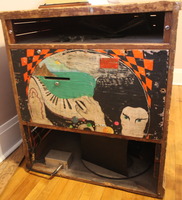 Acquired Leslie 147 sn:84676
Acquired Leslie 147 sn:84676
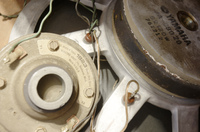 Digging
deeper into replacement drivers
Digging
deeper into replacement drivers
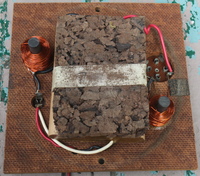 Digging
deeper into Leslie crossover and revisiting the replacement bass driver
Digging
deeper into Leslie crossover and revisiting the replacement bass driver
 Built up
Left Hand Bass octave divider circuits
Built up
Left Hand Bass octave divider circuits
So far, I've had to resolder a broken tone generator wire for frequency
number 27, D below middle C. It may have broken in transit. I also
found a broken drawbar resistor on the upper manual fundamental drawbar.
Other than that, it is working great.
I've also gone ahead and done the Poor Man's
Foldback (video)
mod to this organ to give the high end of
the upper manual a bit more brilliance in the upper octave and a half.
Here's the before and
after wiring and testers.
I'm also interested in the full
foldback mod (photos)
and Lower
manual bass enhancement mod.
2010-10-15: Recapped the ElectroTone Corp. OrganMate spring Reverb amp with a 40/40/20/20uF 500V multi-section cap.
2010-10-16: Recapped AO-29-7 K pre/power amp with power supply recap kit.
Next up is a fluttering D# above middle C tonewheel...
2010-12-09: Acquired beat up Leslie 145. No amplifier, not original treble
and bass drivers. I've wired the output of the M3 power amplifier to
the Leslie crossover input directly. Treble driver is Electro-Voice
1823 110W 8 ohm. Bass driver is marked Yamaha JA-38020 (may
be a Electro-Voice EVM 15B), 8ohm, 120W,
762212, which might be referred to as JA-3802 or JA-3802(0). I'll need to check the crossover which is probably stock, and
change it to C=12.4uF and L=3.18mH (assuming 8 ohms for each driver and
800Hz crossover point). (I don't understand why a stock Leslie
crossover has values of Lh=3.2mH, Ch=7.8uF, Ll=5.2mH, Cl=12.5uF when I
calculate C=6.22uF and L=6.37mH for Likwitz-Riley, C=8.79uF and L=4.5mH
for Butterworth and C=7.13uF and L=5.51mH for Bessel.)
I also need to port it, since the back panel is a cut down 147 panel on
a 145, which eliminated the port.
2011-05-15: I'm acquiring a 20W Leslie 125 amplifier which expects an 8
ohm load anyways. I'll attempt to restore the original circuitry of the
pre-amp pedal too.
2012?: I've restored the Leslie
Combo Preamp (mark I) to original working order, replacing a blown
transistor and resistor and reconnecting the preamplifier circuit board.
The microphone-accident-waiting-to-happen 3-pin XLR female receptacle
carrying 120V to the motors has been replaced with a 6W connector.
2012-10-09: Received a pair of "Left
Hand Bass Kit v2.0" PCBs from
Geoff Williamson to lower the lower manual by an octave. I need to
order parts to populate them. (*
*
*
*
*)
Here's a great set of photos of
the M3 tonewheel generator. And here's the wiring of the M3
keys.
Some links I found
interesting.

(C) 2010 Richard Guy Briggs Web
Page last updated by
Richard Guy Briggs
Fri Dec 20 15:51:15 EST 2019
 Installed and warranty
Installed and warranty
 Testing...
Testing...
 Poor-Man's Foldback modification completed and tested
Poor-Man's Foldback modification completed and tested
 Broken drawbar resistor fix
Broken drawbar resistor fix
 vibrato line,
drawbar guts, reverb, speaker, preamp, cabinet datecode
vibrato line,
drawbar guts, reverb, speaker, preamp, cabinet datecode
 guts:
overall, vibrato scanner, synchronous motor, tonewheel generator,
starter motor, upper and lower drawbars and matching transformer can
guts:
overall, vibrato scanner, synchronous motor, tonewheel generator,
starter motor, upper and lower drawbars and matching transformer can
 AO-29 K
preamp/amp original guts
AO-29 K
preamp/amp original guts
 Recapping ElectroTone OrganMate reverb amp
Recapping ElectroTone OrganMate reverb amp
 Recapping Hammond M-3 AO-29-7 K pre/power amp
Recapping Hammond M-3 AO-29-7 K pre/power amp
 Acquired Leslie 147 sn:84676
Acquired Leslie 147 sn:84676
 Digging
deeper into replacement drivers
Digging
deeper into replacement drivers
 Digging
deeper into Leslie crossover and revisiting the replacement bass driver
Digging
deeper into Leslie crossover and revisiting the replacement bass driver
 Built up
Left Hand Bass octave divider circuits
Built up
Left Hand Bass octave divider circuits

